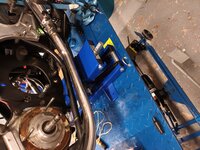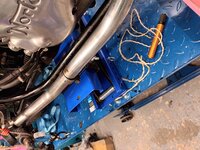You are using an out of date browser. It may not display this or other websites correctly.
You should upgrade or use an alternative browser.
You should upgrade or use an alternative browser.
Suitable bike lift for fatboy
- Thread starter Dave Edwards
- Start date
Dave Edwards
Club Member
I have a manual Clarke they do an air one for a compressor too it copes with what i use it for the first one lasted 22 years and this new ones 4 yrs old decent wheel clamps and strap points its had glides softails sporty and most things on em both , removable rear plate is damm useful for rear wheel removal good height with locking bar and slow bleed lower is good too removable ramp is a boon when space is limited it works for me and a fat boys no probs as had a few in get a small center lift for raising back of bikes for wheel changes and voila ace all round kit
ive decided on the big blue pick it up saturday morning thanks againBig Blue for me. It makes everything SO much more accessible and it does NOT fill the entire bloody garage.
It lifts my 19 Road Glide easily and I have full confidence in it. Just go easy the first few times until you get your clamping/lifting technique smooth.
My 82 Sturgis is on it right now. The only downside to a Big Blue is nowhere to place your tools and stuff (to my mind, the ONLY upside of a table lift).
I solved that problem with a 20 quid 3-tray metal trolley with castors from Aldi that was on special a couple of years ago. That and a seat with castors.
Another thing: almost every table lift now is made in China. Go to hell. Big Blue is well made in England, so THREE thumbs up!. (I will just about accept a cheap trolley from the Far East, but not bike/car parts or a hugely expensive critical bit of garage kit)
Want a USA-made table lift? There are only 2 or 3 options left, and you will pay damn near the price of a used 1980s Sportster...
Dave Edwards
Club Member
ive decided on the big blue thanks again for all your help
Mark Hammond
Committee
Did you ask for the club discount on the purchase price of the Big Blue?ive decided on the big blue thanks again for all your help
Dave Edwards
Club Member
Did you ask for the club discount on the purchase price of the Big Blue
Yes ive just picked it up got £34.00 off great company to deal with would highly recommend themDid you ask for the club discount on the purchase price of the Big Blue?
El Hombre
Club Member
There's a lot to be said for a lift that you can wheel out of the garage when not needed. I cover my big blue in protectant and leave it outside when I'm not using it. Bloody marvelous thing it is. You can stick the bike on it and wash it outside if you like. Then blow it off with the compressor.
Andy from Sandy
Registered User
Some of the differences between the cheap ones and the branded ones will be material, construction and quality along with certified testing and this will be reflected in the price.
First off the quality of the screw thread and the roll pin highlighted are very important (shown below) as they are all that stops these lifts collapsing, yes that single roll pin holds the whole lot together. I do have a fiend who had this pin fail and the lift collapsed, luckily the bike just dropped and fell on the side stand which was down as it was not that high up! (It was not a Sealy or branded one)
View attachment 1192407
The other main difference between the Sealy and most of the cheaper ones is the Sealy uses bearings for the movement of the platform rather than plastic / nylon rollers which can brake crack etc. and should be inherently stronger and far less likely to fail causing the lift to get stuck, tilt and or collapse.
With a bit of time on my hands I looked up the shear strength of roll pins. The one on my small lift like pictured is at least 1/8" in diameter. This chart leads me to believe a pin that size is good for 1000lbs if not more.
ROLL/SLOTTED/SPRING PINS | zero products inc.
ETA: Giving a good margin for error / safety these small jacks ought to only be used for Sportsters, IMHO.
Last edited:
SJC69
Club Member
After my mates lift collapsed I looked into the roll pins shear strength and they far exceed any bolt, so anyone should not considering replacing the roll pin with a nut and bolt.
However what I did discover was that if a smaller pin is fitted within the existing pin, ensuring the slots do not align you can increase the shear strength considerably above that of the original signal pin.
So being unsure of the source of the original fitted roll pin in my lift I replaced it with quality British made pins, fitting a smaller pin inside the larger.
Update:-
Right it has taken ages to find where I got this about the pins from...
https://www.keysandpins.com/products/roll-pins
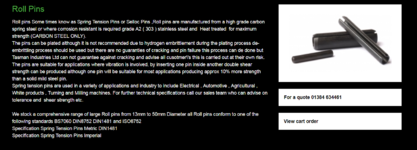
However what I did discover was that if a smaller pin is fitted within the existing pin, ensuring the slots do not align you can increase the shear strength considerably above that of the original signal pin.
So being unsure of the source of the original fitted roll pin in my lift I replaced it with quality British made pins, fitting a smaller pin inside the larger.
Update:-
Right it has taken ages to find where I got this about the pins from...
https://www.keysandpins.com/products/roll-pins

Last edited:
SJC69
Club Member
Virtually all the screw thread scissor lifts. Item # 3What sort of lift and where were the roll pins applied please.
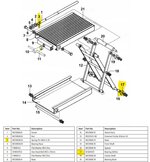
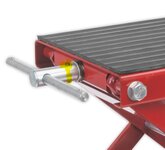
I have to say I am truly amazed that Sealy actually list a full range of spare parts for this lift including the rubber mat!!
https://www.sealey.co.uk/product/5637191833/450kg-scissor-stand-for-motorcycles#spare-parts
Last edited:
Andy from Sandy
Registered User
A thrust bearing is a thrust bearing and I am surprised it broke. They do come as 3 bits and do need greasing before use.
The chart I put up earlier shows that a pin around 6.5mm in diameter is good for more than 3000lbs. It is bigger than the pin in the jack I have here so it does perhaps pay to pay a bit more!
The only negative is the length of part #11. I use a 1/2" drive ratchet on mine and is super easy to turn as it has a 22mm hex shaft on it.
The chart I put up earlier shows that a pin around 6.5mm in diameter is good for more than 3000lbs. It is bigger than the pin in the jack I have here so it does perhaps pay to pay a bit more!
The only negative is the length of part #11. I use a 1/2" drive ratchet on mine and is super easy to turn as it has a 22mm hex shaft on it.
Last edited:
SJC69
Club Member
All bearings are manufactured to a quality and rating in some form, get cheap unsuitable bearings and they will disintegrate very quickly, if the bearing did, first time under load it certainly was not fit for the job, lubricated or not!A thrust bearing is a thrust bearing and I am surprised it broke. They do come as 3 bits and do need greasing before use.
On my cheap one from fleabay the bearing (no. 4 in the diagram) disintegrated on the first use lifting a Dyna Super Glide .
Thin metal casing split shedding small ball bearings over the garage floor.
Now if that bearing was a caged ball bearing this would most likely never to be up to the job. For a task like this a bearing needs to be high load and have maximum surface area to handle and distribute the load, so would normally be a caged needle roller type as shown from the Sealy spare parts.
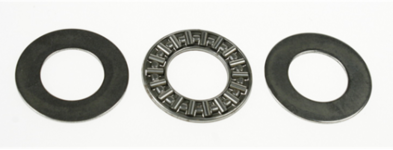
The only negative is the length of part #11. I use a 1/2" drive ratchet on mine and is super easy to turn as it has a 22mm hex shaft on it.
You are not wrong there, it is more difficult, however there are a lot of the other quality lifts like the Draper 04991 which have the 22mm hex and also have bearings for rollers rather than plastic/nylon.
The only issue you may get with the 22mm socket is if someone uses a drill/impact driver to run it up quickly and/or hit the limit, damaging the thrust bearing and gear drive!
Andy from Sandy
Registered User
It requires a thrust bearing and they do come in a few different types but the one on mine is typical, the balls are in a retainer and the two thrust washers are grooved for the balls to run in. With no grease it could well be the balls had so much friction the retainer took the brunt of it. The retainer should only be there to keep the balls spaced apart.
I used to fly RC helicopters and they use the same thrust bearings to support the main blades. When at full tilt there is an outward pull that is in the same order of load as this jack with a bike on it. I have never seen any thrust bearing in a model fall apart but over time the balls will mark the washers and most manufacturers are sourcing bearings from China.
Unless many people come forward with a similar failure I guess it can be expected that from time to time it will happen. This is no different to a radial wheel bearing on our bikes just giving up the ghost at some point.
I used to fly RC helicopters and they use the same thrust bearings to support the main blades. When at full tilt there is an outward pull that is in the same order of load as this jack with a bike on it. I have never seen any thrust bearing in a model fall apart but over time the balls will mark the washers and most manufacturers are sourcing bearings from China.
Unless many people come forward with a similar failure I guess it can be expected that from time to time it will happen. This is no different to a radial wheel bearing on our bikes just giving up the ghost at some point.
Last edited:
Dazzlin
Club Member
I use a Clarke hydraulic table for my 2016 Fat Boy and had no issues.Any1 used a clarke or sealey lifting table rated at 450kg ..looking use it for my 2016 fatboy any advice would helpful
It makes getting the rear wheel out far easier with the removable panel.
I also use the Blue scissor type lift as Batman's photo's (I think it's Draper) just to lift the rear up to get the spindle aligned and not trying to do it the hard way. Works like a dream
SJC69
Club Member
Many shovel head owners will be familiar with the below clutch throw out caged roller thrust bearing and will confirm they can disintegrate quite regularly even when lubricated!
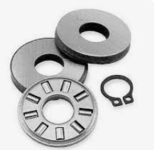
The selection, design and type of bearing is down to the task & type of load it will encounter, in the cases of the scissor lift it is an ideal candidate for a thrust bearing as all the load will be a thrust (axle) load, no radial load.
The load of the bike being lifted will be exerted through that bearing due to the design and therefore a caged needle roller rather than ball will handle this and last longer due to the surface area.
The bearing is made up of three parts, the other two should ideally be hardened, ground flat, surfaces for the rollers/balls to run on or can be for balls, a grooved race, however they do need to be pre-loaded in order to prevent slipping between the bearing's rolling element and the races.
In the case of a lift, rotating slowly, very little lubricant should be required, as said the cage is simply there to space the rollers/balls and keep them in place and will do as long as they all rotate and are round.
Any lack in any of the three parts will cause the collective bearing to bind and fail very quickly, it all goes back to design & quality, generally cheap lifts will have cheaper, components such as lower quality bearings, caged ball rather than the more expensive needle, not be hardened or flat and will most likely not function or last as well.
https://science.howstuffworks.com/transport/engines-equipment/bearing3.htm

The selection, design and type of bearing is down to the task & type of load it will encounter, in the cases of the scissor lift it is an ideal candidate for a thrust bearing as all the load will be a thrust (axle) load, no radial load.
The load of the bike being lifted will be exerted through that bearing due to the design and therefore a caged needle roller rather than ball will handle this and last longer due to the surface area.
The bearing is made up of three parts, the other two should ideally be hardened, ground flat, surfaces for the rollers/balls to run on or can be for balls, a grooved race, however they do need to be pre-loaded in order to prevent slipping between the bearing's rolling element and the races.
In the case of a lift, rotating slowly, very little lubricant should be required, as said the cage is simply there to space the rollers/balls and keep them in place and will do as long as they all rotate and are round.
Any lack in any of the three parts will cause the collective bearing to bind and fail very quickly, it all goes back to design & quality, generally cheap lifts will have cheaper, components such as lower quality bearings, caged ball rather than the more expensive needle, not be hardened or flat and will most likely not function or last as well.
https://science.howstuffworks.com/transport/engines-equipment/bearing3.htm
Andy from Sandy
Registered User
If that style of thrust bearing falls apart and is only doing light clutch duty I won't be choosing one of those over what is already installed and successfully working for the last 5 years on my cheap jack.
Perhaps the mighty MoCo buys cheap stuff just like many of us!
Perhaps the mighty MoCo buys cheap stuff just like many of us!
Last edited:


